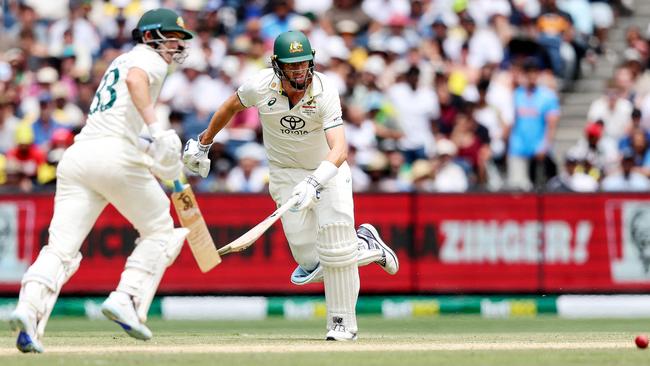Australia take points in game of cat-and-mouse
With the Test, and series, in the balance, Pat Cummins and Marnus Labuschagne engaged in a 20-minute period of cat-and-mouse with the Indian skipper.

Explaining Test cricket to a non-fan is difficult. Try breaking down the nuances and the quirks that only the game can produce. What do they know of Test cricket who only Test cricket know, to paraphrase from CLR James’s Beyond The Boundary.
It’s inexplicable. There’s nothing quite like it. There are often no rational explanations. “It’s just Test cricket”, is sometimes the only thought that springs to mind.
Let’s take these two scenarios that both played out on day four of the Boxing Day Test.
Firstly, you had a batter shielding his partner from a specific bowler and even refusing singles at a time his team desperately needed runs. Once that partnership was broken, the shielded batter then took on the role of protector against the same bowler.
And then at the end of the day, the bowler in question was taken for 14 runs in the last over by a batter who had previously been shielded against him by another batter who himself had earlier been protected against the same bowler.

Confused? Mesmerised? Need a drink? Maybe something stronger? Yes, to all of it.
Test cricket, you mad, mad thing. Never change. Please never change.
There are no prizes for guessing the bowler here. Of course it’s Jasprit Bumrah. And of course there was great thought put into who was allowed to face the demon fast bowler, and when.
But to really get your head around how the two aforementioned scenarios really transpired, we need to dive into that exact period of play, that lasted some 25 minutes before the tea break on Sunday.
Marnus Labuschagne and Pat Cummins were together in the middle, desperately trying to fight off the Bumrah storm. The pace wizard had already shaken Australia off the solid foundation they seemed to have built for themselves over the first three-and-a-half days. Then hurricane Bumrah blew away their middle-order. Travis Head, Mitchell Marsh and Alex Carey, all snuffed out with little fuss.

A dramatic collapse of 4-11, with Bumrah claiming 3-1. That left Australia reeling at 6-91, even if the lead was a decent, but not safe, 196.
Labuschagne had by then got his eye in, and even had some luck go his way. But it was important that he forged a partnership with his captain to steady the ship. That mainly involved a cat-and-mouse game with Indian captain Rohit Sharma dictating how the visitors used their ace weapon.
Bumrah would eventually bowl 24 overs, spread across nine spells. Rohit used his enforcer judiciously in short bursts. Bumrah had of course delivered, like he always does.
But as soon as Rohit saw Labuschagne show a keenness to horde the strike against Bumrah and keep Cummins away from the batting crease, the Indian skipper used his strike weapon even more cautiously, even handing him a one-over spell.
The plan was straightforward and telegraphed from both sides.
Labuschagne and Cummins would make sure that the frontline batter was always on strike for the start of an over, leaving Rohit to question whether to turn to Bumrah. The tactic was employed even if it meant turning down singles, when runs were at a premium. Every time an over came to an end, the attention turned to Rohit and Bumrah. But with Labuschagne on strike, Rohit held back. Instead turning to his other bowlers. It was like a game of chess. It was classic Test cricket with both teams reading the play but refusing to make the big move. It was a case of who blinks first. But what Cummins was also doing was trying to score off the other bowlers, complicating the calculation for Rohit.
Australia benefited in the process. Not only in terms of keeping a fired-up Bumrah at bay, but also to give themselves momentum at a time India had stormed back into the contest.
The duo managed to score 31 runs in seven overs from the time Rohit replaced Bumrah after the one-over burst, scoring easily off Akash Deep, Mohammad Siraj and Ravindra Jadeja.
It also allowed Cummins to get his eye in, and for Labuschagne to build on his impressive start. It would eventually lead to a vital 57-run stand that would give Australia the upper hand.
An advantage driven home by a damaging last-wicket partnership between Nathan Lyon, who was the one who scored 14 off Bumrah in the last over, and Scott Boland to put the home team in a strong position going into the final day, with a lead of 333 runs.
But it was the game of cat-and-mouse that helped Australia turn the corner.
That’s Test cricket. Now, go try explaining that.
Test cricket, you mad, mad thing. Never change. Please never change.







To join the conversation, please log in. Don't have an account? Register
Join the conversation, you are commenting as Logout